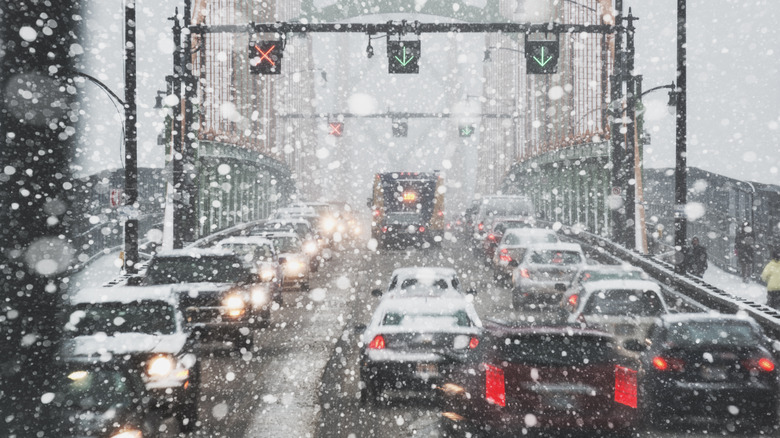Wintertime isn’t all it’s cracked up to be. There are the short days, the freezing temperatures, and the slippery sidewalks — all while you’re wearing layer upon layer of clothing that makes it even more difficult to move around.
Winter is especially challenging for travel — specifically, road travel. And while winter hiking in national parks and hitting up ski destinations might seem fun, there’s one major detail that can put a damper on even the most well-planned winter getaway: getting stuck in the snow on your way there.
According to reports by the U.S. Federal Highway Administration, 24% of a year’s road accidents happen on snowy or icy roads — injuring 116,800 people and killing 1,300. As for traffic disruptions, 15% of non-recurring delays on the road are typically caused by snowy or foggy conditions — meaning there’s always a chance that you might get delayed or, worse yet, stranded. And if you ever do find yourself in the unlucky situation of getting stuck out in the snow, the most important thing is not to panic. There are a few ways to ensure that you’ll stay safe and warm — all in time for help to arrive.
Stay in your car
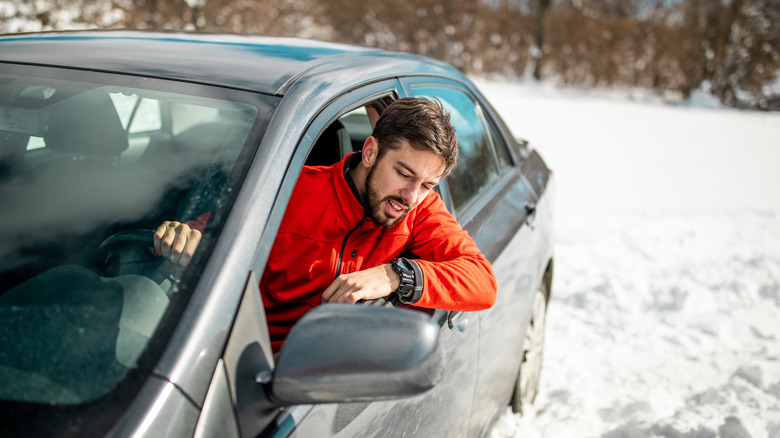
First and foremost, one of the most important things that you should do is to stay inside your car and fight the urge to try and get help yourself. Not only can leaving your car behind put your vehicle at risk — as well as create potential hazards for other drivers who might be passing by — but it also puts you at risk of getting lost or injured.
Especially during a snowstorm or blizzard, things are going to be a lot colder outside your car than inside. This means that, if you choose to leave the warmth of your vehicle, there’s a higher chance that prolonged exposure to the cold might lead to hypothermia — where your body loses heat faster than it can produce it — and frostbite. So, unless you know there’s shelter nearby — stay in your car, close all the doors and windows, and try to call for help.
Keep an emergency bag in the trunk
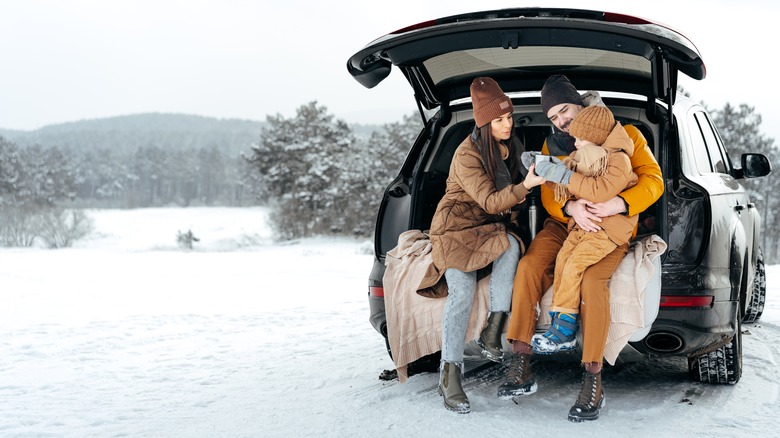
Whether it’s a sudden snowstorm or an unexpected breakdown, it’s always best to be prepared for the worst than to get caught empty-handed — especially on a long-distance winter road trip. That’s why, in order to avoid any further complications, having an emergency go-bag — or “stay-bag” in this case — stored in your car’s trunk can make the difference between a comfortable wait and a potentially dangerous situation.
As for what to put in it, some essential items include wool socks, gloves, a waterproof jacket, wool hats, and, if possible, an extra pair of fleece-lined bottoms in case you need to layer up. Additionally, you’ll also want to have weather-appropriate tools. According to a 2021 survey from insurance comparison provider The Zebra, items like an ice scraper — which 35% of people agree is the most vital — along with a flashlight (25%), kitty litter or sand to increase traction (25%), and traction mats (15%) are all crucial for winter emergencies.
Beyond clothing and tools, you should also try and stock up on snacks and water to make your wait more bearable. Ideally, you’ll want to have non-perishables — think nuts, trail mix, crackers, and granola bars — that aren’t too salty, as excess salt will only make you thirstier. Other options for snacks include beef jerky and freeze-dried camping meals that’ll keep you full for longer. Lastly, having fresh water on hand is also essential. After all, you really don’t want to be venturing outside to try and collect snow if you happen to get thirsty while you wait.
Find other ways to stay warm
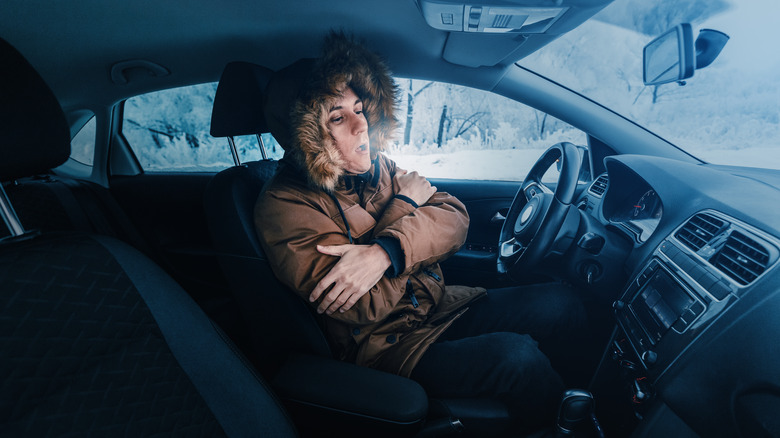
frantic00/Shutterstock
Staying safe when you’re stuck in your car is a waiting game. This means that, in addition to ensuring you have the necessary supplies to hold you over, you also need to find ways to make sure you stay warm — along with whoever else is in the car with you. Although it might seem tempting to keep the car running with the heater on, this will only eat up your fuel — which you might need once the weather starts to clear up. Instead, Dr. Steve Mitchell, medical director at Seattle’s Harborview Medical Center, told the New York Times that you should run your car for up to 10 minutes per hour in order to maximize fuel efficiency and still keep things toasty.
If you are going to be running your car, you also need to ensure that your exhaust pipe isn’t getting clogged up. Otherwise, carbon monoxide will start to build up inside your car and lead to dangerous consequences, including carbon monoxide poisoning, brain damage, heart issues, and, possibly death.
Along with using your car’s heater, you can also insulate your car using blankets or extra clothing to cover any gaps where you feel the cold might be getting through.
Help searchers find you
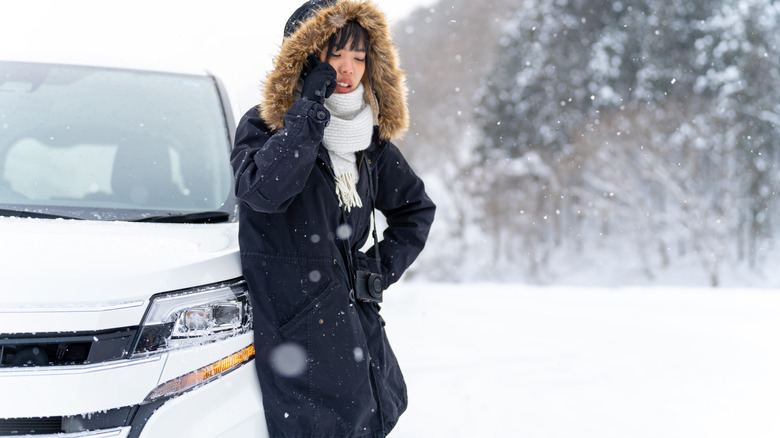
Candyretriever /Getty Images
Asking for help is essential if you ever get stuck in a winter storm, especially if you’re in a remote destination. If your phone battery is running low, a great way to let others know you need help is to send your location to a friend or loved one who can then alert emergency services of where you are.
Once you’ve called for help, the next thing to do is to make yourself — and your vehicle — as visible as possible in order to help increase your chances of being spotted quickly. To do so, experts at the National Weather Service recommend that you tie a bright-colored cloth to your car’s antenna or door, and that you keep the dome light turned on while the car is running. Then, once the snow, rain, or hail have stopped, open the hood of your car to signal that you’re having an emergency.
Getting back on the road
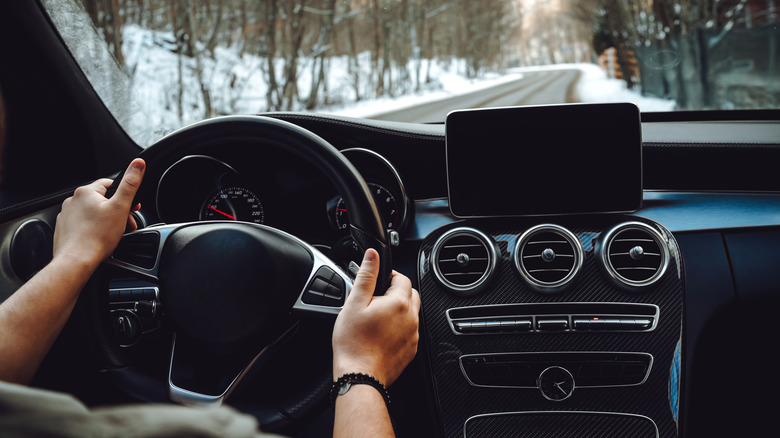
bogubogu/Shutterstock
Driving after a bad winter weather episode might feel a little daunting, but with all the necessary precautions, your next getaway should be smooth and safe until you reach your destination.
Per AAA’s suggestions, if you’re thinking about hitting the road during the winter, you’ll want to take your time and drive slowly, accelerate and decelerate gradually, not use cruise control, and maintain a greater distance between you and the cars ahead of you — at least 5 to 6 seconds — to ensure you can brake in time. Additionally, Geico suggests not stopping on hills — regardless if you’re going up or down them — since this can cause your tires to spin and lose traction in the snow. (Geico also recommends an 8-to-10-second distance between you and the cars ahead of you.)
If weather conditions quickly turn unsafe during your drive, the best option is to slow down as much as possible, turn your hazard lights on, and find some shelter so you can wait it out. No destination is ever worth risking your safety — especially when the risks clearly outweigh the benefits.

